If you were creating a scavenger hunt that captured the history of New York City’s tiny Duane Park and its surroundings, you could use anything from eggs, butter, bog grass, and Dutch coins to 19th century shoes, coconut, banjos, and a dish of chocolate soufflé. That would begin to hint at the many layers of history, from pre-European settlement to today, of this less-than-an-acre patch of green in Tribeca and its nearby buildings and streets.
Duane Park is a small triangle lying where Duane Street splits into two just west of Hudson Street. Before the Dutch arrived in the early 1600s, this area was a boggy meadowland when the Native Americans inhabited what is now Manhattan. These days Duane Park is a place that tells New York history from the last couple of centuries in visual shorthand. The sole remaining remnant of a large farm established in the 17th century, it is New York’s second oldest public park and the first open space that the city acquired specifically for use as a park.
Around the park are streets and buildings that convey a neighborhood’s varied lives through time. It has had a couple of lives as a residential neighborhood – first primarily in the early 19th century and again today. These have been sandwiched around a commercial era when Tribeca and the streets around the park were teeming with food warehouses for eggs, butter, cheese, meat, and pickles. This business took hold in the late 19th century and peaked from the 1930s to the 1950s.
Change occurred again in the 1960s and 1970s. Once the warehouse commerce diminished, the area became dilapidated until artists began to move in to the large buildings and rejuvenated the neighborhood. Today, it’s again residential with well-kept, gorgeous old buildings, and spaces fetching lofty prices. It’s also a center of haute cuisine in restaurants such as Bouley, with chocolate soufflé, porcini flan, and the like on its menu.
Stroll Downtown
Fancy addresses notwithstanding, it almost feels like a little Main-Street-in-town when walking up Hudson from Morgan’s Market to Duane Park. Simply looking around Duane Park’s corners allows one to peel back many layers of history and interpret them in the architecture, envisioning what it was like at those times. Those differing lives say much about just how durable and flexible buildings can be. Or you can sit on one of its graceful benches and enjoy how tranquil and lovely Duane Park is just off the bustle of Tribeca’s other streets. During one recent weekday lunchtime, fewer than a dozen people came in and out.
This patch of open space, with its greenery, flowers, trees, pathways, and black wrought-iron fence, is the last vestige of a farm, or bouwerie. The Dutch governor, Wouter Van Twiller, granted 62 acres to Roeloff and Annetje Jans, in 1636. When Roeloff died soon afterward, his widow – reputedly a very spirited woman – married the Reverend Everardus Bogardus, second minister of the Dutch Church of New Amsterdam. (Before she married again, she looked out for her offspring, stipulating that her children from the first marriage should receive 1,000 Dutch guilders from their father’s estate, according to an article on Jans by George O. Zabriskie.)
The property changed from Dutch to English ownership. In 1671, five of Annetje Jans’ heirs conveyed the property to the English governor, Sir Francis Lovelace. The Duke of York confiscated the land in 1674, and in 1705 the English rulers granted it to Trinity Church. Trinity, a large holder of real estate, sold this small triangle of land for $5 in 1797 to New York City for use as a park.
The first formal garden was planted at Duane Park as early as 1804, according to Christopher Gray in a New York Times article, citing the research of Tribeca historian Oliver Allen. For much of the 19th century, this area remained largely residential until the 1860s and 1870s when commercial elements started to move in and a building boom began, resulting in many of the treasured buildings we see today.
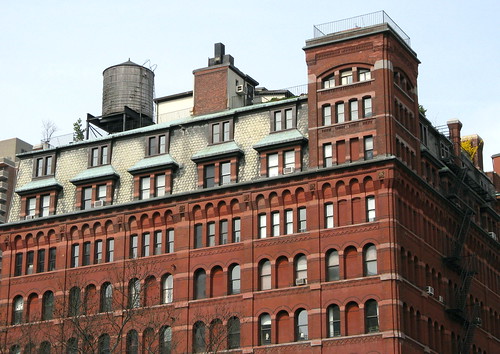
View north of the park: the 1881 Romanesque Revival-style Schepp Building at 165 Duane St., where Leopold Schepp made a fortune processing dried coconut. It’s now residential.
The park has likewise undergone many changes, often reflecting the neighborhood’s personality. It has had times of beauty and decline. For a time following an 1870s facelift, it was picturesque but totally fenced off from the public – like a precious Victorian object – until the city opted to open it and other small parks up. Calvert Vaux, co-designer of Central Park, created a verdant space in Duane Park with winding pathways.
Duane Park reflected the grittier industrial era in the mid-20th century, when the city paved parts of it over and put in a concrete barrier. Those working for the egg and butter dealers and other food industries sat on its benches for lunch. The Times’ Gray wrote of how sculptor Richard Serra, who lived on Duane Street for 20 years, recalled that food workers would gather in the park during midday and play music on their banjos and harmonicas.
The Little Park That Could
As warehouses closed and the city fell on harder times financially, the park’s condition deteriorated. Finally in the 1990s, a group of concerned neighbors were fed up with seeing litter, damaged areas, and a barren place. They formed the Friends of Duane Park, raised funds, and worked very hard to bring back the park and complete a redesign that would restore it to the earlier ideal of a greener setting. (You can read more about the park’s history and design at the Friends of Duane Park site.)
Today, if parks earned honors for the vistas of history and architecture they pack in a small space, tiny Duane Park would surely be on top. So many textures, styles, and building details greeted my eyes, whether I was sitting in the park or walking around its perimeter and nearby streets: deep-orange brick, rust-colored terra cotta, blue-gray cast iron with glass blocks, large Romanesque arches, warehouse stoops, and more. Someday I’ll try the soufflé at Bouley, but to my way of thinking a bench in Duane Park, open to all, is the best seat around.
Here are some of the particular buildings and views in and near Duane Park, followed by a slide show.
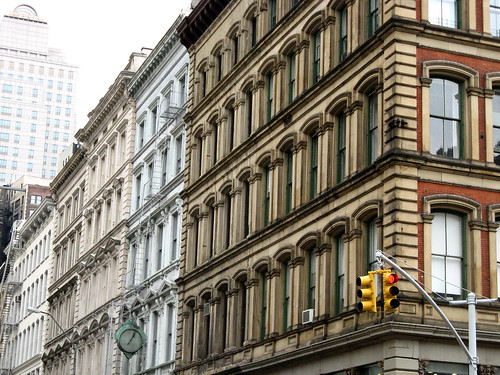
Building fronts along Duane Street in Tribeca
South of the park: 172 Duane St.
This building definitely grabs attention for its eclectic feel. The latter-day owner of the building at 172 Duane St., built in 1872, recessed the facade to leave its cast-iron front as a kind of sculpture, according to Allen, the historian. The structure is a former food warehouse.
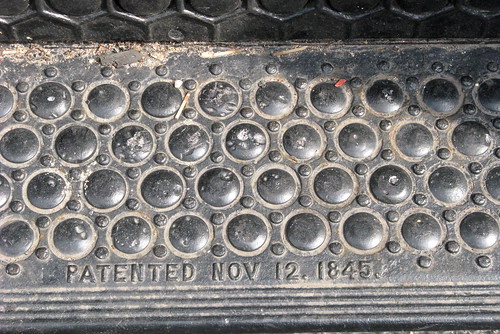
A section of a vault-light step, on a building at the corner of Hudson and Duane streets
The area around Duane Park, and Tribeca in general, has amazing building details. This cast-iron step is marked “Patented Nov 12, 1845.” The date is when Thaddeus Hyatt received a patent for cast-iron vault lights, the kind found on the outside steps of this building at Hudson and Duane streets. The system, incorporating small glass lenses in cast-iron panels, allowed daylight to pass into building areas such as basements so they could be productive work areas. Makes me wonder how much light truly came into those work spaces.

Former Mohawk Electric Building, across Hudson Street from Duane Park
The Romanesque Revival-style former Mohawk Electric Building at 161 Duane St., once home to the Mohawk Electric Company, was constructed in 1892. Architect and developer Joseph Pell Lombardi completed a major restoration project to turn the structure, which had become a storage facility in disrepair, into condominium residences, according to the Downtown Express. The restaurant Bouley is located at street level.
The dwelling is part of the two-building Mohawk Atelier residential-loft complex, along with the 1845 red “Whalebone Building” at the rear. From the park’s vantage point, it’s worth admiring this building not only for its huge arches, windows, and other architectural features, but the creamy orange brick and russet stripes of sandstone that the developer had carefully cleaned and restored.
Visit the slide show larger in Flickr.
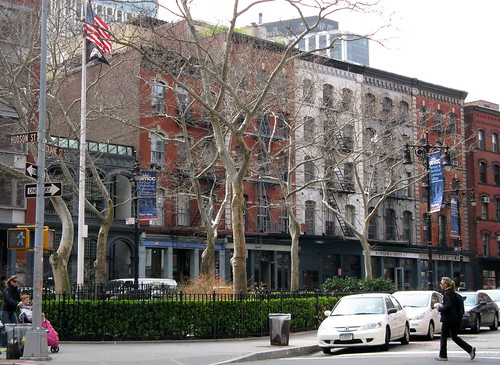
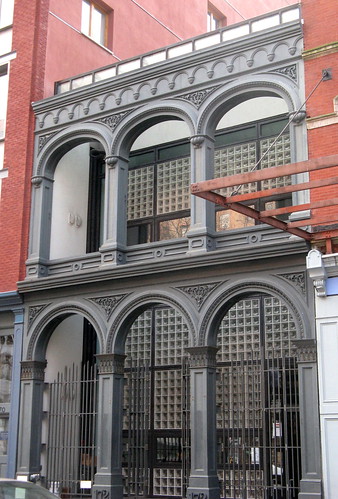




I wonder how many New Yorkers walk past this charming location each day without knowing what they are unintentionally ignoring. Your detailed history of Duane Park and the surrounding architecture should be cast in bronze and displayed in the park for the reading pleasure of all “mindful walkers” in the area.
Nita,
Thanks! Gauging by how many people walked by that day, I do think the park is easy to ignore. And we all have our destinations we’re rushing off to, especially New Yorkers on a weekday. Still, it is a gem of a little place!
Susan
I thought this was really cool to discover. My brother, father, and grandfather are all James Duane. Maybe I am related in some way.
Gregg,
Thank you, and that is very intriguing that your brother, father, and grandfather are all named James Duane. Do you know how many generations of your family have been in New York City and State?
Here is a biography of James Duane, for whom Duane Street, and thus Duane Park, were named, in the Biographical Directory of the United States Congress. This page outlines some of the James Duane and Duane family papers that are in the possession of the New-York Historical Society. Also, here is the historical marker on James Duane, in case you haven’t seen it.
Good luck if you follow up on genealogical investigating.
Susan
Thanks for doing this! I am working on a project about Duane Street in 1853, where young Samuel Clemens boarded during his first trip to NYC. I am overlaying a Google map of the street today with locations from 1853. Your page here is a gold mine for Duaniana.
Hi Terry,
That sounds like a fascinating project! Are you able to see in your mind’s eye what Duane Street looked like at that time? I just poked around a bit and found that the young Sam Clemens boarded on that street at the age of 17 and worked in a Manhattan printing shop, setting type (and I’m guessing that you already know this from your research).
What led you to focus on 1853?
The way you are overlaying a Google map sounds like a great way to depict this place over time.
Would love to be kept posted on your project. As I say, fascinating!
Susan
Hi Susan,
The year 1853 is easy. In August of that year, teenaged itenerant printer Samuel Clemens came into NYC as part of his mission to see all of those grand places he’d read about in books. The letters he wrote to his sister mention that he was lodging on Duane St., but the address was not provided. Some experts say that because there were 18 or so known lodgings on Duane, we’ll never know which one. But he left clues such as the distance to the library and his work that help a lot to narrow it down. It’s not entirely hard to envision the street then, because some of the buildings are still standing, and the information in the city directories paints a picture of an industrial area. Enjoy!